Old-school anime bots go wild in this video pieced together from the robot battle scenes in Toei's 1965 animated film Gulliver no Uchuu Ryokou ("Gulliver's Space Travels" or "Gulliver's Travels Beyond the Moon"). The video was created by Steven Wagner of Astropolitan Pictures, and the soundtrack is Japanoise band Melt-Banana's "Alpha Boost," which was remixed for Salvo Beta's Evil Against Evil compilation.
Tag: ‘Art’
Itasha: Pimped rides, otaku style
This is what happens when otaku start pimping their rides...
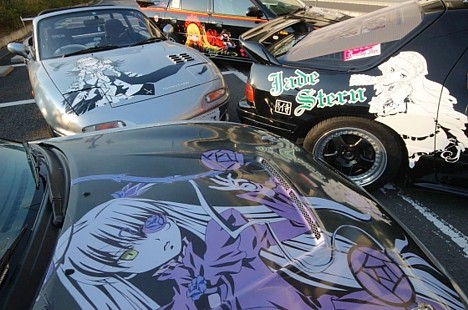
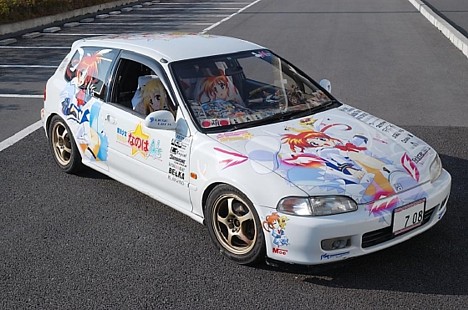
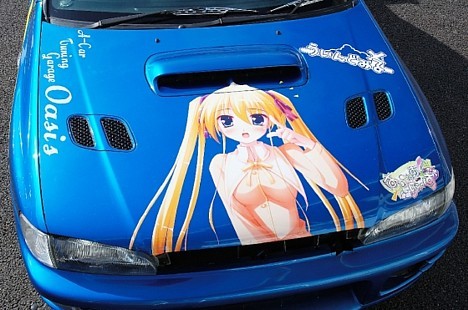
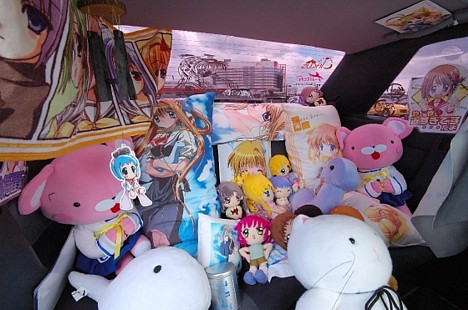
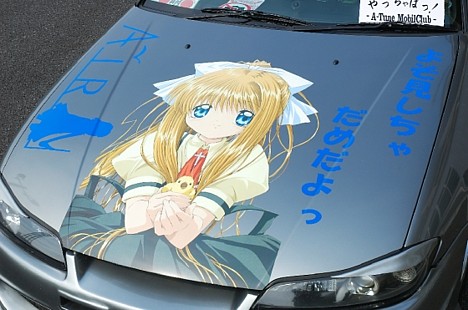
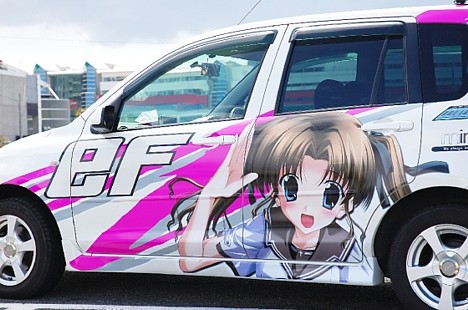
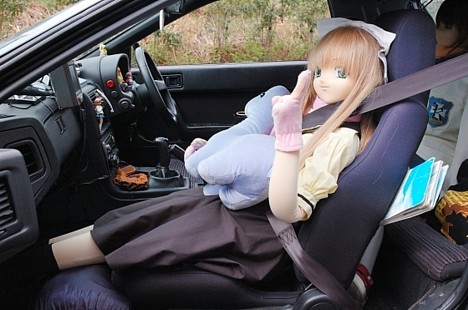
See more of these itasha photos at New Akiba, which takes a peek inside Itasha Road 2007, a recently published mook profiling over 150 itasha and their proud owners.
Itasha are cars decorated with decals and paint jobs depicting anime, game and manga characters. The word itasha, which literally means "painful car," is derived from the kanji for itai ("painful") and sha ("car"). The word also appears to be a reference to the Italian sportscar, also known as itasha (although the ita for Italian is spelled with katakana instead of kanji), a conventional sort of chick magnet driven by a different sort of guy.
Otaku itasha have been around since the late '80s, but they have remained relatively rare, perhaps because people have traditionally felt the need to keep their otaku nature to themselves. But as the subculture goes mainstream and otaku develop a greater sense of pride, more itasha are bound to be taking to the streets.
Check out the following sites for more awesome pictures of itasha:
- Yoshimu's blog (via Danny Choo)
- ASCII 24 p.1, ASCII p.2 (via Japanator)
- Painful Style
[Via: /. Japan]
Platinum Gundam
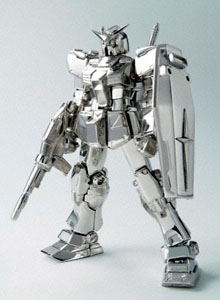 Bandai and Ginza Tanaka have teamed up to create a Mobile Suit Gundam made from pure platinum. Called Gundam Fix Platinum, the 12.5-cm (5-in.) tall, 1.4-kg (3-lb.) work features 89 separate parts and a head adorned with a 0.15 carat diamond. Hajime Katoki, a mechanical designer and illustrator noted for his work in a range of anime and games, oversaw the two-year long production process.
Bandai and Ginza Tanaka have teamed up to create a Mobile Suit Gundam made from pure platinum. Called Gundam Fix Platinum, the 12.5-cm (5-in.) tall, 1.4-kg (3-lb.) work features 89 separate parts and a head adorned with a 0.15 carat diamond. Hajime Katoki, a mechanical designer and illustrator noted for his work in a range of anime and games, oversaw the two-year long production process.
According to the Bandai press release, the aim of the platinum Gundam masterpiece is to combine the pure, rare and eternal nature of platinum with the everlasting Gundam worldview. While Ginza Tanaka hopes to attract attention to the beauty and value of platinum, Bandai hopes to boost Gundam's name recognition around the world, nearly 30 years after the first anime episode aired on Japanese TV.
The platinum Gundam will be exhibited at BASELWORLD 2007, an annual watch and jewelry show held in Basel, Switzerland beginning April 12. After that, it will return to Japan.
There are currently no plans to sell the Gundam, but Bandai estimates its value at $250,000 (30 million yen).
[Sources: Fuji Sankei, Bandai press release]
Turban Noguchi: Money as origami

Paper money is not just for spending -- it is also great for origami.
The Asahi website has posted a story about "Turban Noguchi," a popular origami made using a 1000-yen bill. The bill features a portrait of Hideyo Noguchi, the noted physician and bacteriologist who, among other things, discovered the agent of syphilis in 1911. By folding the money, you can outfit Noguchi with a turban or other fancy headgear.
Asahi credits a Mr. Nakajima, a 29-year-old Nagoya resident, with inventing the original Turban Noguchi origami technique. According to the article, Nakajima discovered Turban Noguchi by accident one night when playing around with his money. "I was shocked by Noguchi's bizarre appearance," he says.
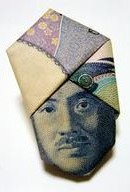 Since then, he has compiled a number of variations, some of which are featured on the Turban Noguchi no Sekai ("The World of Turban Noguchi") website. A couple of links to instructional YouTube videos also appear on the site. This video, for example, shows how to fold a standard Turban Noguchi, and this video shows how to make wedding rings from a 1,000-yen bill and a 5,000-yen bill. Nakajima offers a word of warning to overzealous origami enthusiasts, though -- too much folding can destroy the money, so be careful.
Since then, he has compiled a number of variations, some of which are featured on the Turban Noguchi no Sekai ("The World of Turban Noguchi") website. A couple of links to instructional YouTube videos also appear on the site. This video, for example, shows how to fold a standard Turban Noguchi, and this video shows how to make wedding rings from a 1,000-yen bill and a 5,000-yen bill. Nakajima offers a word of warning to overzealous origami enthusiasts, though -- too much folding can destroy the money, so be careful.
Another website, called Turban Noguchi to Yukai na Nakama-tachi ("Turban Noguchi and His Delightful Companions"), features an AMAZING gallery of origami made with paper money. Highly recommended.
[Via: Asahi]
Edo-period kappa sketches
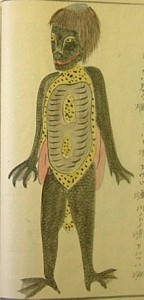 Kappa, arguably Japan's most well-known creature of legend, are mischievous river imps notorious for luring people -- particularly children -- into the water to drown and eat them. They smell like fish, enjoy cucumbers and sumo, and are said to be very courteous despite their malicious tendencies.
Kappa, arguably Japan's most well-known creature of legend, are mischievous river imps notorious for luring people -- particularly children -- into the water to drown and eat them. They smell like fish, enjoy cucumbers and sumo, and are said to be very courteous despite their malicious tendencies.
Although kappa are typically about the size of a child and greenish in color, they can vary widely in appearance. They frequently have a turtle-like shell and scaly skin, but sometimes their skin is moist and slick, or coated in fur. Most walk upright on their hind legs, but they are occasionally seen on all fours. Regardless of body type, the top of the kappa's head usually features a bowl-shaped depression containing water. The water inside this bowl is the source of the kappa's power.
The Edo period (1603 to 1867) saw some serious scientific literature devoted to the study of these creatures. Suikokouryaku (1820), for example, is a compendium of kappa-related information gathered from a variety of sources from Japan and China. The book, which is housed in the Iwase Bunko Library, includes kappa sketches by artist Kurimoto Tanshu. Here are a few.
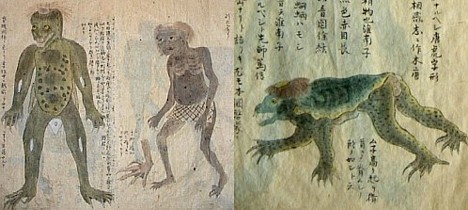
The kappa on the left, sketched by Ito Chobei, was captured during the Meiwa period (1764 to 1772) in Edo, somewhere in present-day Tokyo's Edogawa ward. When the creature was shown to Ota Chogen, a noted herbalist of the time, he identified it as a kappa -- he happened to have a kappa sketch with him that showed a creature with strikingly similar features. According to the text in the book, this kappa measured 60 cm (2 ft) tall and had slippery skin like that of a catfish.
The middle picture above shows a type of kappa with no shell, and the picture on the right shows a kappa that was caught in a net in Mito, Japan in 1801. This kappa had a prominent chest, a crooked back and three anuses.
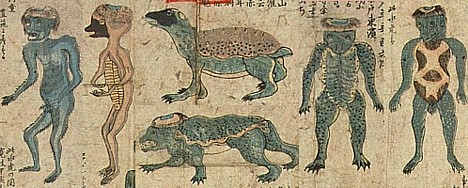
Later in the Edo period, an illustrated guide to 12 types of kappa (Suiko juni-hin no zu) was produced based on information taken from Suikokouryaku. A portion of this document is shown above. Check out the complete, high-resolution version here.
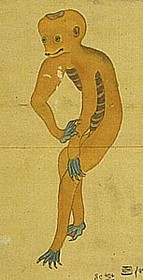
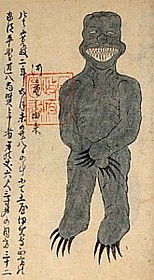
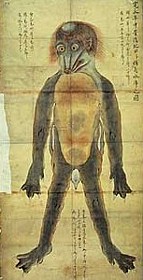
Ito Keisuke, a well-known man of medicine and prolific natural history artist in the Edo period, sometimes included depictions of mysterious creatures with his animal drawings -- like the kappa on the left above, for example. The middle picture shows a kappa that was observed in one of the moats around Edo castle in the late 18th century. The picture on the right shows a kappa observed in the early 17th century in what is now the city of Hita in Oita prefecture (Kyushu). This kappa looked sort of like a turtle standing on its hind legs, and it had a depression on its head, webbed fingers, and splotches on its chest and abdomen.
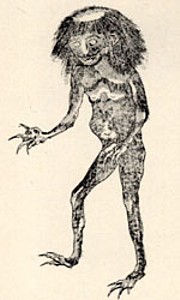
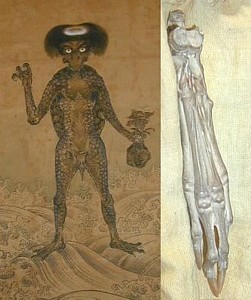
The neneko (or neko) kappa, shown on the left above, was sketched by Akamatsu Sotan in his 1855 work entitled Tonegawa zushi ("Illustrated History of the Tone River"). This kappa was known to move to a new location along the river each year, causing trouble wherever it went.
The image on the right shows a kappa scroll and kappa hand belonging to Sougenji (a.k.a. Kappa-dera, or "kappa temple") located in the Ueno-Asakusa area of Tokyo. The temple is one of countless places in Japan that has stories and legends of kappa associated with it. According to this temple's legend, the surrounding area was once a basin with poor drainage, making it prone to flooding. A local raincoat maker (the Japanese word for "raincoat" is "kappa") took it upon himself to construct a series of drainage ditches, which he was able to complete with the help of a kappa living in the Sumida River. It is said that people fortunate enough to lay eyes on this kappa were blessed with success in business.
For lots more background information and kappa links, check here.
Videos by Koichiro Tsujikawa (+ Cornelius)
Koichiro Tsujikawa is a self-taught video artist who began as a graphic designer and visual producer for live concerts. Here are a few of his surreal works...
- Untitled (2004): This short film about an alien athlete was commissioned by Panasonic for the 2004 Olympics.
- Eyes (2004): This video was commissioned by Getty Images as part of The Big Idea, where filmmakers created short pieces from Getty Images content (check the link for other cool shorts). Soundtrack by Cornelius.
- Fit Song - Cornelius (2006): Household objects go crazy when stop-motion video meets computer animation. From the album "Sensuous."
- Beep It - Cornelius (2006): Also from the "Sensuous" album. More stop-motion madness with household objects.
Check out Koichiro Tsujikawa's homepage for more background info and links to other videos for Cornelius, as well as for UA, Rip Slyme, and more.
World’s most complex origami
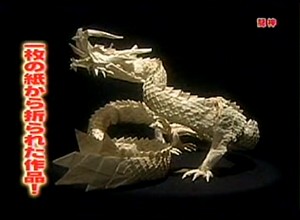 Check out this video showing three amazing creations by master origamist Satoshi Kamiya. Hard to believe, but each of the pieces shown in this video was folded from a single sheet of paper.
Check out this video showing three amazing creations by master origamist Satoshi Kamiya. Hard to believe, but each of the pieces shown in this video was folded from a single sheet of paper.
The red dragon, made from a 1.2 x 1.2 meter sheet, took only 6 hours to fold. The yellow hornet was commissioned by luxury retailer Hermes and was put on display in their New York store. The white dragon is fashioned from a 2 x 2 meter sheet of paper. "As far as I know, it is the most complex origami in the world," says Kamiya in the video.
Check out Kamiya's gallery for photos of his other paper creations.
[Via: Japan Probe]
La sekintani dot oni
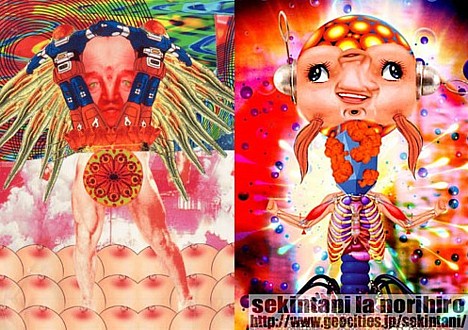
Medical book meets manga meets porn in Norihiro Sekitani's insane collages. (Not exactly safe for work.)
[Link: la sekintani dot oni]
Gemotion screen shows video in living 3D
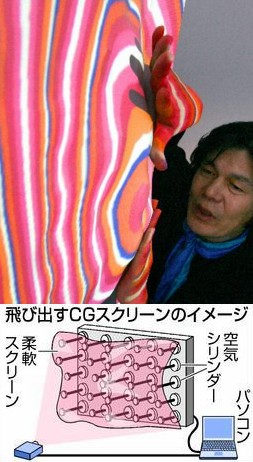 Here's a groovy display for people looking to add that extra dimension to their viewing material...
Here's a groovy display for people looking to add that extra dimension to their viewing material...
Gemotion is a soft, 'living' display that bulges and collapses in sync with the graphics on the screen, creating visuals that literally pop out at the viewer.
Yoichiro Kawaguchi, a well-known computer graphics artist and University of Tokyo professor, created Gemotion by arranging 72 air cylinders behind a flexible, 100 x 60 cm (39 x 24 inch) screen. As video is projected onto the screen, image data is relayed to the cylinders, which then push and pull on the screen accordingly.
"If used with games, TV or cinema, the screen could give images an element of power never seen before. It could lead to completely new forms of media," says Kawaguchi.
The Gemotion screen will be on display from January 21 to February 4 as part of a media art exhibit (called Nihon no hyogen-ryoku) at National Art Center, Tokyo, which recently opened in Roppongi.
[Source: Asahi]
